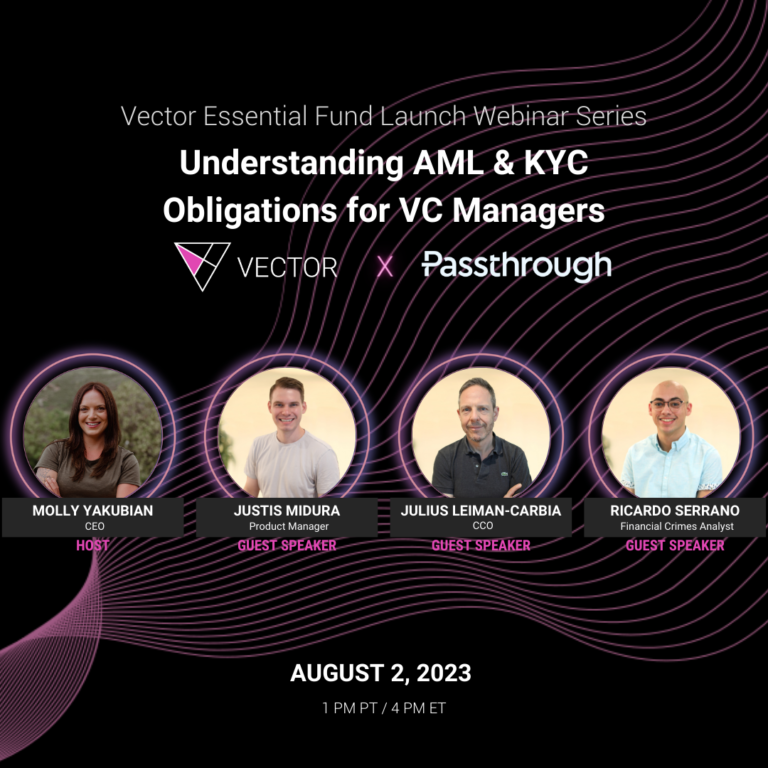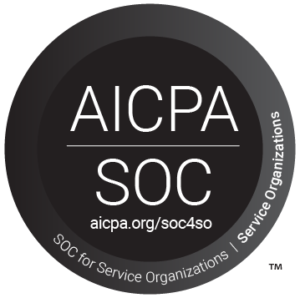Last week, our CEO and Managing Partner, Molly Yakubian, was joined by Passthrough’s Chief Legal and Compliance Officer, Julius Leiman-Carbia, Financial Crimes Analyst, Ricardo Serrano, and Product Manager, Justis Midura, to discuss AML and KYC obligations for fund managers. Throughout this blog, we’ll be sharing the key points from our third webinar session from the series.
What is KYC/AML?
AML and KYC are vital aspects of the financial industry’s efforts to combat illegal activities. Anti-Money Laundering (AML) is a set of regulations designed to detect and prevent money laundering, where illicit funds are disguised as legitimate transactions. Know Your Customer (KYC) refers to the process of verifying the identity of customers to ensure they are not involved in fraudulent or illegal activities.
Interestingly, AML and KYC requirements may or may not apply to investment advisors (depending on firm and fund jurisdictions), but sanctions, which restrict certain transactions or dealings with specific entities or countries, apply universally.
The significance of KYC and AML has grown due to increased scrutiny from banking institutions, which are obligated to adhere to these regulations. Moreover, banks have extended these obligations to their clients, particularly those introducing investors into the banking process. Recognizing that external entities can introduce risks to their operations, banks have cascaded the KYC and AML obligations to create a more comprehensive approach to combating financial crimes.
What are the differences between KYC and AML as it pertains specifically to fund managers and what are the primary objectives and requirements?
KYC and AML play distinct roles in the context of fund managers. KYC involves understanding the relationship with customers and verifying their identities and ownership structures. On the other hand, AML is more focused on detecting and preventing money laundering activities, where clients use financial organizations to clean proceeds from illegal sources.
Preventing money laundering helps identify and prevent illicit activities, protecting both the firm’s reputation and financial interests. Compliance with guidelines and best practices shields firms from potential harm associated with dealing with illicit individual or entities. Secondly, maintaining regulatory compliance is crucial in the current landscape, even if not explicitly mandated by regulatory acts. Adhering to these guidelines is essential to avoid strict liability in case of any involvement with problematic counterparties.
How do you navigate pushback from investors with these newer KYC/AML processes?
The changing geopolitical environment, the collapse of certain banks in the venture space, and the US government’s increased focus on KYC/AML have driven the need for more stringent processes.
Investors may voice complaints about the need to undergo these procedures, especially if they have not encountered them before. In response, it’s best practice to adopt a risk-based approach and help investors understand the reasons behind the requirements. By pointing out the relevant rules and regulations, fund managers can facilitate a conversation with investors, presenting the rationale for the KYC/AML processes.
Flexibility is also essential, as not all situations are the same. Any exclusions or exceptions should be well-documented to ensure compliance and address potential audit concerns.
What happens when there is a positive result for an adverse media check, AML search, or a politically exposed person?
When conducting an adverse media check, AML search, or identifying a politically exposed person (PEP), a thorough and systematic process is essential to ensure compliance and mitigate potential risks. The first step in this process involves diligence on the verification of the investor’s identity, a key aspect of KYC. Many firms require investors to submit relevant documents based on a KYC checklist within the fund’s subscription packet, which outlines the entities that can be admitted into the fund and the data points required.
The verification process becomes more complex when dealing with entities with multiple layers of ownership. It requires an iterative approach to identify the ultimate beneficial owners and controllers of the investing entity. This can be challenging and time-consuming, but it is crucial for establishing a comprehensive understanding of the investor’s ownership structure.
After collecting the necessary documentation and data, fund managers run searches using third-party software. These searches scan for potential hits on various lists, including sanctions lists, politically exposed persons, and adverse media. The results of these searches are then compared to the submitted data to determine if there are any true or false positives.
Challenges arise in the onboarding process, especially regarding the ownership structure and the timing of document requests. Identifying the beneficial owners and understanding the complex entity structures can be difficult. Additionally, determining the best time to request documents is crucial to avoid delays and the need for post-closing remediation.
An effective tool for streamlining the onboarding process is to ask for all necessary documentation and complete the KYC process before closing. This approach ensures that any potential risks are addressed beforehand and mitigates the risk of post-closing complications. While some firms may not be required to conduct KYC/AML processes by their banks yet, it is considered a best practice to do so to proactively adhere to potential future regulatory requirements and to protect your firm from reputation, financial, or other risks and liabilities.
How do any of these complexities change or processes differ if you’re dealing with international investors coming into your fund?
Dealing with international investors can add complexities to the KYC/AML processes, as the regulatory requirements vary depending on the jurisdiction involved. When a U.S.-based fund is seeking to bring in foreign investors, it must comply with U.S. regulations, such as those from FinCEN and other major regulators. Similarly, if the fund is based in another jurisdiction, it needs to adhere to that specific jurisdiction’s regulations.
The primary goal remains the same: to identify the ultimate beneficial owners of the investing entities. However, the documentation and ownership structures can differ significantly between countries. Therefore, it is essential to ensure that the documents provided by foreign investors comply with the relevant jurisdiction’s requirements.
In the case of U.S.-based funds with foreign investors, the process involves verifying the ownership structure of the foreign entities and cross-referencing the provided data against international lists and databases. This step ensures thorough due diligence and compliance with global standards.
It’s worth noting that the jurisdictional differences can be substantial, with some locations having more conservative ownership thresholds and distinct processes for document certification. For instance, conducting KYC in the United States may be relatively straightforward compared to jurisdictions like the Cayman Islands, which have more demanding requirements.
To navigate these complexities effectively, having a local representative or compliance officer in the relevant jurisdiction can be highly beneficial. They can provide insights and expertise in handling the specific KYC/AML processes required in that area.
In cases where funds have master-feeder structures with both onshore and offshore components, additional attention must be given to the AML requirements, especially in jurisdictions like the Cayman Islands, which have more rigorous compliance obligations, including designating an AML compliance officer.
Should firms also be doing adverse media searches?
Firms should adopt a risk-based approach when considering whether to conduct adverse media searches on top of the KYC process. While there is no obligation to perform adverse media searches, it is a good practice to understand the potential risks associated with the individuals or entities they are dealing with.
Adverse media searches involve monitoring public sources for any negative information or media coverage related to the individuals or entities in question. However, these searches can generate a significant number of false positives, making the process challenging to manage. To streamline the process, some firms may use shortcut methods, such as running names through lists that flag potential connections to criminal activities or organized crime.
Although adverse media searches can provide valuable insights into the background of investors and help identify potential money laundering risks, it is essential to balance the benefits with the resource-intensive nature of the process. Leveraging list-based shortcuts can offer a higher degree of risk tolerance without requiring extensive human capital.
Ultimately, the decision to perform adverse media searches should be based on the specific risk profile of the investors and the firm’s risk appetite. Taking a risk-based approach allows firms to prioritize their efforts and allocate resources more effectively, ensuring compliance with regulatory requirements and mitigating potential risks associated with dealing with individuals or entities with adverse media history.
What are the recent regulatory changes that venture capital professionals should be aware of as it pertains to AML and KYC?
Recent regulatory changes that venture capital professionals should be aware of in relation to AML and KYC includes the beneficial ownership information reporting regulation implemented by FinCEN, which takes effect from January 1, 2024. This regulation aims to enhance transparency and requires corporations and similar entities to report their beneficial ownership structures directly to FinCEN. Venture capital firms need to be prepared to provide accurate documentation and comply with the reporting requirements.
The regulatory landscape is evolving rapidly, with an uptick in the implementation and enforcement of AML and KYC regulations over the past 3 to 5 years. The government’s focus on transparency and compliance is evident in the increasing stringency of guidelines for dealing with investment structures and investors. The current FCC is proactive in developing new regulations, and it wouldn’t be surprising to see further extensions of KYC to investors in the future.
Notably, the geopolitical environment is impacting regulatory changes, with concerns about the influence of certain countries. As a result, venture capital firms must carefully review the investors and their structures to avoid potential risks associated with sanctioned individuals or entities. Deep sanctions reviews and committee processes can help ensure compliance and mitigate risks when dealing with unfamiliar investors.
What are the tangible risks associated with sanctions?
The tangible risks associated with sanctions primarily revolve around the contractual relationship with the bank. While it is theoretically possible for FinCEN to initiate enforcement actions against anyone, including funds, it is relatively unlikely, especially for smaller, less prominent fund structures.
However, the real risk lies in the actions taken by the bank. If the bank perceives that a fund or organization poses too much risk, they may send their audit team to investigate further. In more severe cases, the bank may decide to cease processing the fund’s activities, leaving the organization in a difficult position.
Since funds rely on banks to transfer money and assets, being cut off by the bank can create significant operational risks and disrupt the fund’s ability to serve its clients effectively. For smaller funds, the risk of losing the banking relationship can be especially damaging.
How should fund managers handle a hit that isn’t a false positive?
Handling a hit that isn’t a false positive requires a case-by-case approach, taking into consideration the nature of the hit and the specific circumstances surrounding it. In some instances, the situation may be quite clear-cut. For example, if there is a true positive for a sanctioned individual on an official list, the fund manager would likely need to refuse to do business with that person. If an existing investor becomes sanctioned, the fund manager might need to take remediation actions, such as freezing their assets in an interest-bearing account.
On the other hand, certain hits may not present significant risks to the fund, and a risk-based approach may be more appropriate. For example, hits related to political exposure need careful evaluation. If it’s a distant relative of a local government official, the risk might be considered low. However, if it involves a close relative of a prominent figure like Joe Biden, the fund manager may need to adopt a different approach.
Ultimately, when faced with a hit, fund managers should thoroughly review the information related to the hit and familiarize themselves with the reasons for its appearance. It might be helpful to reach out to the investor for an explanation, especially if the investor is classified as politically exposed. Some checklists may even proactively ask investors if they have political exposure and request a description of the nature of that exposure. This enables the fund manager to verify the investor’s claims and make informed decisions about whether the hit poses a significant risk.
In all cases, the fund manager should ensure compliance with regulatory requirements and take appropriate steps to mitigate any potential risks associated with the hit. Seeking legal counsel and employing a risk-based approach can aid in making well-informed decisions that align with the fund’s compliance obligations and risk tolerance.
What are some practical tips in terms of the analysis associated with those potentially false positives?
Practical tips for analyzing potentially false positives involve a combination of common sense, online research, and proper documentation. When faced with a hit that may seem like a false positive, one can start by conducting a Google search to find additional data points and verify whether the individual matches the sanctioned entity. Comparing information such as name, birthday, and photo ID can be helpful in making a determination.
If the Google search does not yield conclusive results, communicating with the investors themselves can provide valuable information. For domestic investors, this is a practical option, but for foreign investors, it may not be as feasible or informative.
In cases where further clarity is needed, seeking legal counsel’s assistance to evaluate the contents of the alert and provide expert insights can be beneficial. Legal professionals can help interpret complex situations and provide guidance on how to proceed.
Importantly, it is crucial to document the steps taken to analyze the potential false positives. Keeping a record of the processes used, the results of the research, and the rationale behind the decision-making demonstrates good judgment and due diligence. Proper documentation is valuable during audits or regulatory inquiries, showing that the fund manager exercised diligence in handling the potential risk.
Conclusion
Thank you again to Julius, Ricardo, and Justis for an amazing panel and expertise on KYC and AML regulations!
Disclosure: The content presented in this blog post is based on notes taken during a webinar and is intended for informational purposes only. The information provided in this blog has not been reviewed or verified for accuracy by any official or authoritative body. While every effort has been made to ensure the reliability and accuracy of the content, readers are advised to use their discretion and judgment before relying on the information provided herein. The authors and publishers of this blog disclaim any responsibility for any errors, omissions, or consequences arising from the use of this information. For official and comprehensive information on the subject matter, we recommend referring to reputable sources or seeking professional advice.
ABOUT VECTOR
Vector AIS is a next-generation fund administrator and technology company for closed-end investment funds.
At Vector, we strive to create an inspiring, inclusive, equitable workplace that celebrates and values employees. As we continue to scale, we do so with a responsibility to foster a culture of inclusivity and balance that allows teammates to thrive at work and in their personal lives.
Join the team, become a client, or follow us as we execute our mission.




